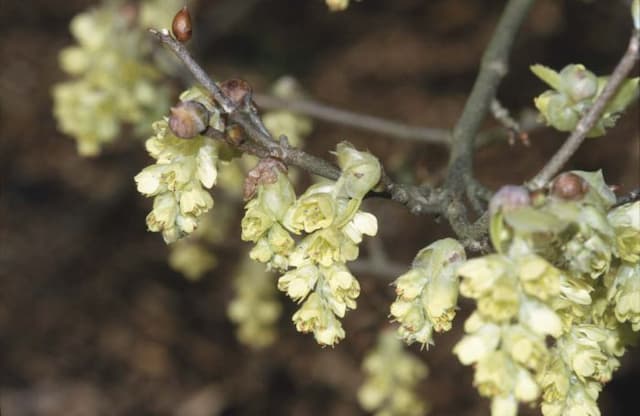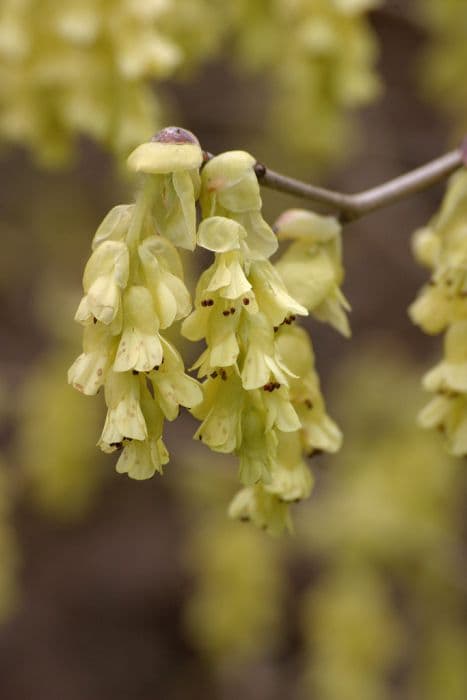Witch Hazel Hamamelis × intermedia 'Rubin'

ABOUT
Hamamelis × intermedia 'Rubin', commonly known as witch hazel 'Rubin', is a deciduous shrub that is highly prized for its ornamental qualities. The most striking feature of this witch hazel variety is its large, broadly oval leaves that boast a deep green color during the growing season, transitioning to beautiful shades of yellow, orange, and red as the autumn season progresses. The foliage offers a colorful display that enhances the garden's appeal during the cooler months. The witch hazel 'Rubin' is well-known for its unique flowers that appear in the depths of winter when most other plants lie dormant. The blooms possess a ribbon-like appearance, with long, slender petals curling outward in a spidery fashion. The flowers exhibit a rich, reddish-copper color that gives this plant its cultivar name 'Rubin', referring to the gemstone ruby. The blossoms are not only visually striking but also emit a subtle, pleasing fragrance that adds an additional layer of enjoyment to the winter garden. The bark of witch hazel 'Rubin' is smooth and gray, providing a neutral backdrop that helps highlight the vibrant foliage and distinctive flowers. The overall form of the plant is broad and rounded, giving it a sturdy and robust appearance in the landscape. The witch hazel 'Rubin' is recognized for its graceful structure, with branches that provide both visual interest in the winter garden and a habitat for local fauna.
About this plant
 Names
NamesFamily
Hamamelidaceae
Synonyms
Hybrid Witch Hazel, Rubin Witch Hazel
Common names
Hamamelis × intermedia 'Rubin'.
 Toxicity
ToxicityTo humans
Witch Hazel 'Rubin' is generally not considered toxic to humans. However, it is always advisable to refrain from ingesting any plant material that is not known to be edible. There is scarce information about the plant causing significant toxicity or poisoning in humans, but as with many ornamental plants, it could potentially cause mild stomach upset if ingested in large quantities.
To pets
Witch Hazel 'Rubin' is typically not toxic to pets. Nonetheless, as with any non-food plant, consumption of the foliage or other parts of the plant by pets may lead to gastrointestinal upset or an allergic reaction in some animals. It is always best to prevent pets from eating ornamental plants to avoid any potential issues.
 Characteristics
CharacteristicsLife cycle
Perennials
Foliage type
Deciduous
Color of leaves
Green
Flower color
Red
Height
12 feet (3.65 meters)
Spread
10 feet (3.04 meters)
Plant type
Shrub
Hardiness zones
5
Native area
Hybrid
Benefits
 General Benefits
General Benefits- Aesthetic Appeal: The plant offers attractive winter blooms with its unique spider-like red flowers, providing color and interest during the colder months.
- Seasonal Interest: It features a variety of seasonal changes including vibrant fall foliage that adds visual variety throughout the year.
- Attracts Wildlife: The blooms can attract pollinators such as bees when flowers are scarce in late winter.
- Low Maintenance: Once established, the Witch Hazel requires minimal care, making it suitable for gardeners of all skill levels.
- Durable: It is generally resilient to common pests and diseases, thereby reducing the need for chemical treatments.
- Adaptability: The plant can adapt to a wide range of soil conditions, though it prefers well-drained, acidic soils.
- Hardiness: It is hardy in a wide range of climates, typically in USDA hardiness zones 5 through 8.
- Privacy Screen: When planted in groups, it can function as an informal hedge or privacy screen.
- Erosion Control: As a multi-stemmed shrub, it can help stabilize soil and prevent erosion on slopes.
- Structural Garden Element: With its woody framework, Witch Hazel can provide structural interest even when deciduous in winter.
 Medical Properties
Medical PropertiesThis plant is not used for medical purposes.
 Air-purifying Qualities
Air-purifying QualitiesThis plant is not specifically known for air purifying qualities.
 Other Uses
Other Uses- Photography: Hamamelis × intermedia 'Rubin', also known as Witch Hazel, can be used in photography for creating natural backdrops or as a subject due to its attractive flowers and foliage.
- Cut Flowers: Branches of Witch Hazel can be cut and used in floral arrangements, particularly for adding a burst of color during winter months.
- Natural Dyes: The bark and leaves of Witch Hazel can be used to extract natural dyes for coloring fabrics or crafts.
- Garden Structure: When not in bloom, the intricate structure of Witch Hazel's branches adds visual interest to gardens during barren months.
- Ornamental Displays: Witch Hazel can be grown in decorative pots and used to enhance patio or balcony settings with its unique flowering habit.
- Insect Repellent: Some gardeners use Witch Hazel to help deter certain insects due to its natural properties, contributing to a more pleasant outdoor experience.
- Photographic Art: Close-up photography of Witch Hazel's distinctive flowers can result in stunning artistic representations for use in galleries or art shows.
- Natural Fencing: When planted in a series, Witch Hazel can create an informal, flowering hedge to divide garden spaces naturally.
- Wildlife Habitat: Witch Hazel can provide shelter and food for birds and other wildlife during the winter months, when food is scarce.
- Crafting Material: Dried Witch Hazel branches can be used in crafting for making wreaths or other decorative items.
Interesting Facts
 Feng Shui
Feng ShuiThe Witch Hazel is not used in Feng Shui practice.
 Zodiac Sign Compitability
Zodiac Sign CompitabilityThe Witch Hazel is not used in astrology practice.
 Plant Symbolism
Plant Symbolism- Hope: The Witch Hazel 'Rubin' blooms in the late winter, often while snow is still on the ground, symbolizing hope through harsh conditions.
- Uniqueness: With distinct, ribbon-like petals, the Witch Hazel 'Rubin' represents standing out from the crowd and embracing one’s uniqueness.
- Healing: The Witch Hazel is widely known for its medicinal properties, so the 'Rubin' variety symbolizes healing and soothing of ailments.
- Protection: Traditionally, Witch Hazel was believed to ward off negative energies, making it a symbol of protection.
- New Beginnings: As an early bloomer, Witch Hazel 'Rubin' signifies the start of something new or the renewal of life.
- Fragility: Though hardy, the delicate appearance of its blooms can be seen as a reminder of the fragility of life.
- Attraction: The Witch Hazel 'Rubin' has a subtle fragrance, which can symbolize attraction and the allure of nature's beauty.
 Water
WaterThe Witch Hazel should be watered deeply once a week during its first growing season to establish a deep, extensive root system. After establishing, water less frequently, but still deep, to encourage root growth. The soil should be kept moist but not soggy. A good rule of thumb is to provide the Witch Hazel with 1 gallon of water per session for smaller shrubs, scaling up to 2-3 gallons for larger plants, depending on the size and environmental conditions.
 Light
LightWitch Hazel prefers full to partial sunlight, with ideally at least 4 to 6 hours of direct sunlight daily. The best spot for the Witch Hazel would be an area where morning sunlight is abundant, and where it can be protected from the harsh afternoon sun if your climate has very hot summers. A location that offers some afternoon shade would be optimal for the plant.
 Temperature
TemperatureWitch Hazel is quite hardy and can tolerate a range of temperatures; it flourishes best when daytime temperatures are between 60°F and 75°F. It can withstand temperatures as low as 0°F but might suffer if temperatures dip below this, and it can also survive up to highs of around 85°F to 90°F before needing protection or additional water to cope with the heat.
 Pruning
PruningPrune Witch Hazel immediately after flowering to shape the plant or to remove any dead or broken branches. Generally, this shrub requires little pruning aside from removing any suckers that appear at the base or any cross branches that may cause structural problems. Pruning is done to encourage healthy growth and airflow, which can reduce disease risks. The best time is late winter or early spring, just after the flowering period.
 Cleaning
CleaningAs needed
 Soil
SoilWitch Hazel 'Rubin' prefers acidic to neutral soil with good drainage. A mix of two parts loam, one part peat, and one part sand or perlite is ideal. The soil pH should be between 5.5 and 6.5 for optimal growth.
 Repotting
RepottingWitch Hazel 'Rubin' does not need frequent repotting and does well when it is slightly root-bound. Repotting every 3-4 years should suffice, preferring early spring before new growth begins.
 Humidity & Misting
Humidity & MistingWitch Hazel 'Rubin' can tolerate a range of humidity levels, but it does best in moderate to high humidity. No need for specific humidity control unless the environment is extremely dry.
 Suitable locations
Suitable locationsIndoor
Place Witch Hazel 'Rubin' near a bright window.
Outdoor
Plant in a sunny to part-shade spot with moist soil.
Hardiness zone
5-8 USDA
 Life cycle
Life cycleThe Witch Hazel 'Rubin' begins its life cycle as a seed, typically requiring stratification to overcome dormancy before it can germinate in late spring. Upon germination, the seedling will grow and establish a root system, during which time it develops into a juvenile plant with characteristic broad, green leaves. As the plant matures into adulthood over several years, it forms a multi-stemmed shrub that blooms with fragrant, reddish flowers in late winter to early spring before the foliage emerges. After pollination, often assisted by wind or insects, the plant produces small capsules containing seeds, which mature by autumn and are expelled explosively to disperse them. This perennial shrub then enters a period of dormancy during the colder winter months. Throughout its life, which can span several decades, the Witch Hazel 'Rubin' will undergo cycles of growth, flowering, seed production, and dormancy.
 Propogation
PropogationPropogation time
Late winter
Propogation: The Hamamelis × intermedia 'Rubin', commonly known as the Hybrid Witch Hazel 'Rubin', is typically propagated by softwood cuttings. The best time for propagation is late spring to early summer when the plant's new growth is still soft and flexible. To propagate, a cutting about 4 to 6 inches long is taken from a healthy branch. The lower leaves are removed, and the cut end is dipped in rooting hormone to encourage root development. The cutting is then placed in a well-draining potting mix, ensuring at least one node is buried where leaves were removed since this is where roots will emerge. The pot should be kept moist and in indirect light until rooting occurs, which generally takes several weeks. Once the cutting has established a strong root system, it can be transplanted to a larger pot or directly into the garden.









